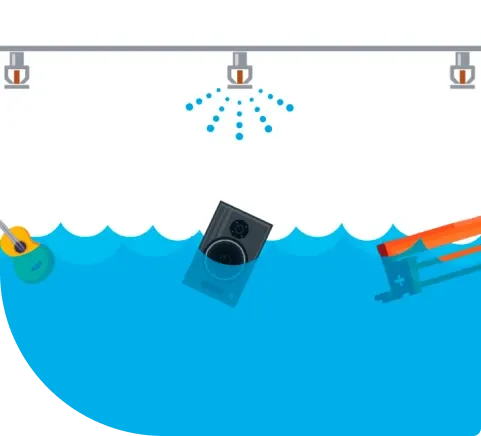Fire Sprinkler System or Plumbing Nightmare?
Article from When Outdated Bylaws Backfire, an edition of our risk management magazine, Resilient Ministry.
10 min read

Sunday services conclude successfully. After you turn out the last light and lock the doors, your fire sprinkler system starts pouring down water—but there’s no fire in sight. For the next 24 hours, nearly 500,000 gallons of water flood your church. All that water could throw a wrench in your ability to do ministry, not to mention the buckled floors, damaged HVAC equipment, ruined electronics, and water-logged pews. The flooding takes an expensive toll on your building. It’ll take months to repair the damage and replace all the destroyed equipment.

Single Broken Sprinkler Head:
15 gallons of water per minute or 900 gallons per hour
Broken Pipe:
20,000 - 40,000 gallons of water every hour
Preventing a Sea of Soggy Hymnals
The worst part is finding out that 10 minutes of routine visual inspection could have uncovered the issue that had been lurking undetected for months. “That’s why it’s so important to take steps to make sure your system is free of wear and tear that can lead to catastrophic failure,” said David Barrueto, a senior risk control specialist with Brotherhood Mutual. It’s also important to protect pipes from freezing, a common cause of devastating water damage.
To maintain their effectiveness, it’s imperative to have a professional contractor perform an annual and five-year inspection. But there are several things your ministry can visually check in the meantime. The good news is that this doesn’t require a lot of time or skill. Here are several things you can do today to catch small issues before they become major problems.
What to Inspect Outside
When performing a visual inspection of your fire suppression system, it’s important to start outdoors. Look at the pipes and valves outside your building for signs of leaks or rusting. “Sometimes rust on the outside can mean it’s rusting on the inside,” said Barrueto. Internal rust can eventually lead to leaks or valves that don’t work correctly. An important piece of your sprinkler system is the backflow preventer. If you see leaks around this component, it could indicate that a seal is broken and should be repaired right away. Make sure to walk along the ground where the water pipe is buried. If there is any sign of water such as a soggy spot, you could have a leak that would require immediate attention. Finally, many systems will have a bell located on the exterior of the building to alert firefighters that the sprinkler system has been activated. Make sure to clear the bell of birds’ nests or other debris so it's audible if it goes off.
What to Inspect Inside
Riser Room— The brains of a fire suppression system are in what’s commonly referred to as a riser room. It’s important to note that not every building will have a riser room. Your system’s main water supply pipes may be in a hallway, outside the building, or in another room.
When visually inspecting the riser pipes and valves, start at the bottom and work your way up. Pay particular attention to signs of leaks, which may indicate more serious problems. Check riser gauges to make sure they are working properly. Take a second to look at the flow switches. These are switches that will have electrical connections, and they are responsible for detecting water flow and sending a signal to the alarm. Sometimes the wires can get disconnected by accident, especially if there’s any work performed on the system. If you have a monitored system and the alarm doesn’t get triggered, it’s possible no one would know for hours or even days.
Pump Room— The pump that provides water to the system may be located outside, in the riser room, or in a separate space within the building. A quick visual inspection is all that’s required to make sure it is free of bird nests or other obstructions. If your system has a water storage tank, make sure it’s not leaking and is full of water.
If you have a leak anywhere in the system, it will cause a smaller pump, known as a jockey pump, to run more frequently to maintain pressure. “Eventually, the smaller, less expensive jockey pump can fail, which makes the larger, more expensive main pump run to maintain pressure,” said Barrueto. Routine visual inspections can catch issues like these before they become expensive repairs.
“The first thing I do when I walk into a pump room is smell for indication of a frequently running pump,” noted Barrueto. If the room has that familiar electrical smell, that’s a good indicator that either the jockey pump or main pump have been running. This is something that should be inspected more closely by
a licensed contractor.
Professional Inspections:
Annual and Five-Year
Fire sprinkler systems should be inspected annually. There is also a more involved five-year test.
The annual inspection tests the basic function of the system. It involves a visual inspection, but it also requires a contractor to test water flow and make sure the appropriate alarms are triggered.
The five-year test is much more comprehensive. It includes the same tests from the annual inspection but adds a complete drain of the system. This tests for any blockages or malfunctions in the system so they can be remedied. The contractor should also check the interior of the riser pipe to see if there is any built-up rust.
To verify if the annual or five-year testing is current, check the testing date sticker located on the riser.
If you don’t currently have a contractor to work on your fire suppression system, it’s important to hire a contractor with a C16 and C17 license. That means they are licensed to work on sprinkler systems and fire alarm systems.
Consider designating someone within your ministry to be present during the inspections. This helps familiarize the individual with the system so they are equipped to perform regular visual inspections between the professional inspections.
Prep Your Life Raft
If a sprinkler head is ever accidentally activated, or if there is an obvious leak, it’s important to know how to quickly turn off the water supply. The shutoff valve can be located either inside or outside the building, so make sure you know how your system is configured and where you can access the shutoff if necessary.
Does the room require a key for entry? Does the shutoff valve have a chain and padlock? Knowing how to access the main shutoff can save your ministry a significant amount of damage in the event of a leak.


